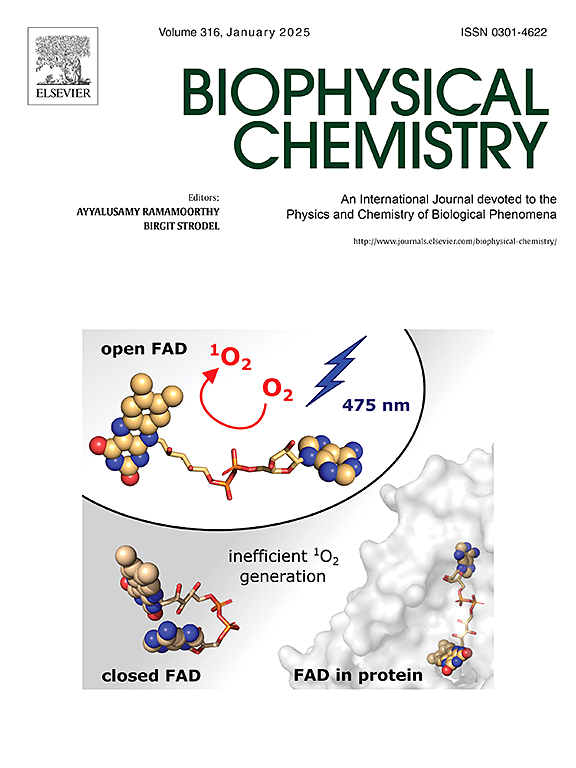Redox-dependent structural and thermal stability of HMGB1: A thermodynamic analysis
IF 2.2
3区 生物学
Q2 BIOCHEMISTRY & MOLECULAR BIOLOGY
引用次数: 0
Abstract
HMGB1 is a highly conserved nuclear protein with functions that depend on its biological environment, which are linked to structural differences in the protein. Inside the cell, HMGB1 adopts a reduced form, regulating DNA transcription. In contrast, in the extracellular environment, it exists in a form with a closed disulfide bridge within the A-box motif playing a role in inflammation. We analyzed the stability of HMGB1 in these two redox states using differential scanning fluorimetry (nanoDSF), which enables high-precision thermal unfolding measurements with minimal protein quantities — something not previously feasible for HMGB1. The A-box domain was found to unfold reversibly in both redox forms, unlike the B-box. Surprisingly, the reduced form showed lower thermal stability but higher enthalpy of unfolding, indicating that it is enthalpically favorable and suggesting a significant difference in entropy contributions. For full-length HMGB1, both redox variants displayed similar thermal stability. However, only the reduced form was able to refold after unfolding; the disulfide form could not return to its native structure. Additionally, the reduced full-length variant exhibited a decrease in unfolding enthalpy, likely due to the destabilizing effect of its negatively charged C-terminal tail. Overall, the redox state has a strong influence on HMGB1's thermodynamic behavior. These thermodynamic differences can be linked to the protein's dual functionality: enhanced flexibility is beneficial for DNA transcription inside the nucleus. At the same time, increased conformational stability is advantageous for extracellular protein-protein recognition pathways.

HMGB1的氧化还原依赖性结构和热稳定性:热力学分析
HMGB1是一种高度保守的核蛋白,其功能取决于其生物环境,这与蛋白质的结构差异有关。在细胞内,HMGB1采用还原形式,调节DNA转录。相反,在细胞外环境中,它以在a -box基序中具有封闭二硫桥的形式存在,在炎症中起作用。我们使用差示扫描荧光法(nanoDSF)分析了HMGB1在这两种氧化还原状态下的稳定性,这种方法可以用最少的蛋白质量进行高精度的热展开测量——这在以前是HMGB1不可行的。与B-box不同,A-box结构域在两种氧化还原形式下都是可逆展开的。令人惊讶的是,简化形式表现出较低的热稳定性,但较高的展开焓,这表明它在焓上是有利的,并表明熵贡献的显著差异。对于全长HMGB1,两种氧化还原变体表现出相似的热稳定性。然而,只有简化形式能够在展开后重新折叠;二硫化形式不能恢复到原来的结构。此外,减少的全长变体显示出展开焓的下降,可能是由于其带负电荷的c端尾部的不稳定作用。总的来说,氧化还原态对HMGB1的热力学行为有很强的影响。这些热力学差异可能与蛋白质的双重功能有关:增强的柔韧性有利于细胞核内的DNA转录。同时,增加的构象稳定性有利于细胞外蛋白质-蛋白质识别途径。
本文章由计算机程序翻译,如有差异,请以英文原文为准。
求助全文
约1分钟内获得全文
求助全文
来源期刊

Biophysical chemistry
生物-生化与分子生物学
CiteScore
6.10
自引率
10.50%
发文量
121
审稿时长
20 days
期刊介绍:
Biophysical Chemistry publishes original work and reviews in the areas of chemistry and physics directly impacting biological phenomena. Quantitative analysis of the properties of biological macromolecules, biologically active molecules, macromolecular assemblies and cell components in terms of kinetics, thermodynamics, spatio-temporal organization, NMR and X-ray structural biology, as well as single-molecule detection represent a major focus of the journal. Theoretical and computational treatments of biomacromolecular systems, macromolecular interactions, regulatory control and systems biology are also of interest to the journal.
 求助内容:
求助内容: 应助结果提醒方式:
应助结果提醒方式:


